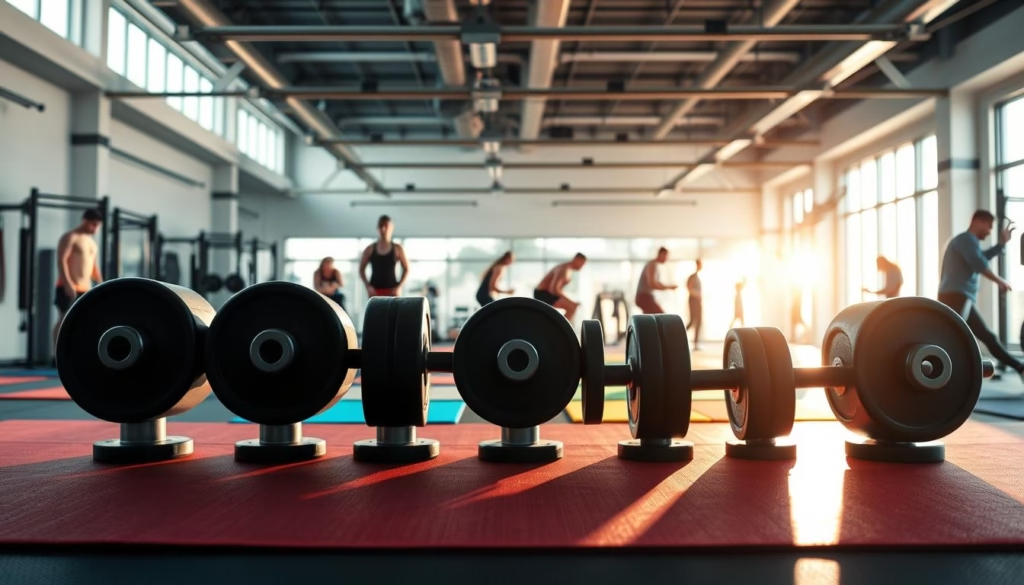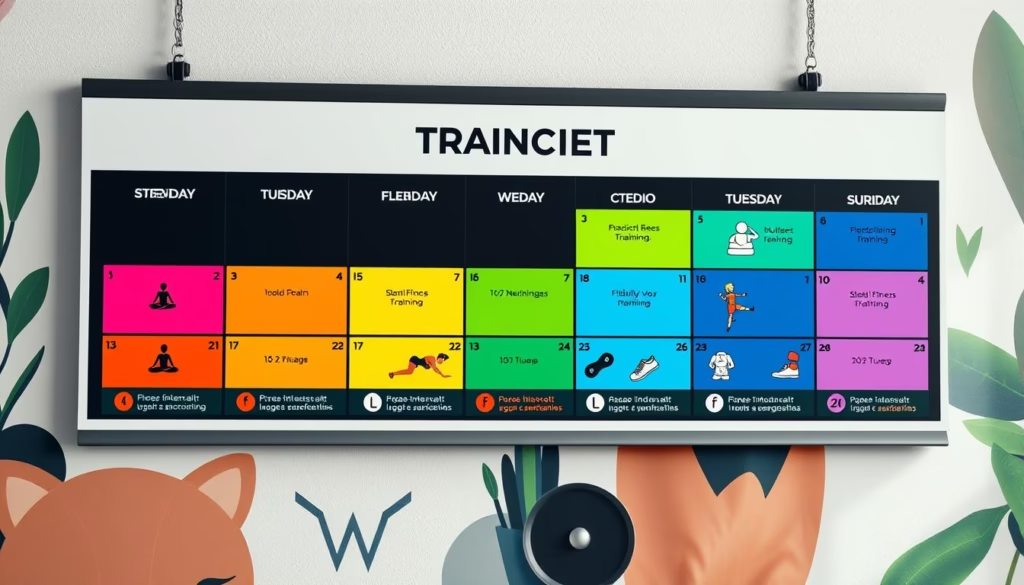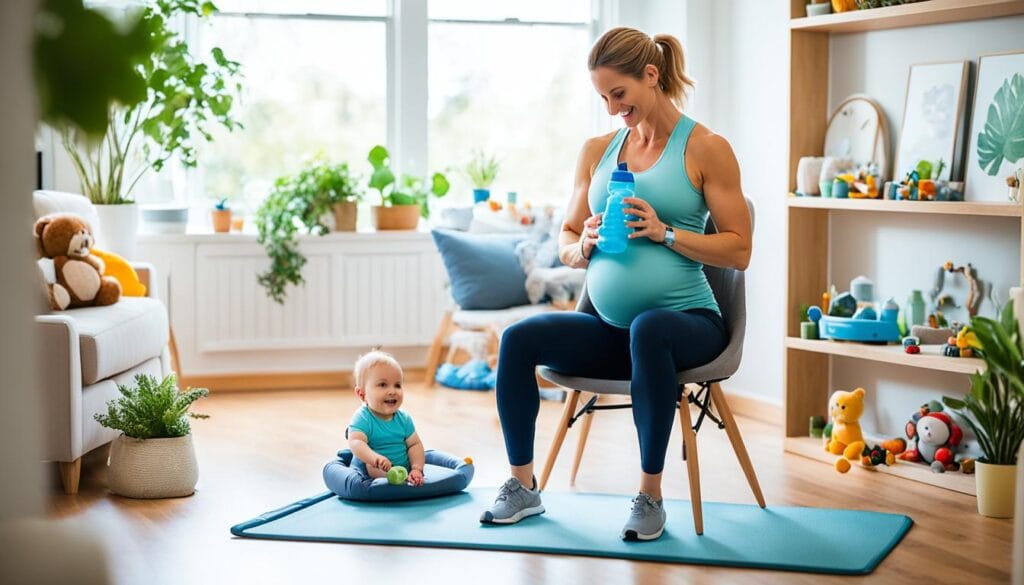Ever wondered why some workouts make you feel agile, while others hurt more than help? The answer might be in functional fitness. This guide will show you the basics of functional fitness for beginners. It focuses on moving without pain. Learning these skills can lead to a healthier, more active life in 2025.
This fitness guide 2025 offers tips on adding functional exercises to your daily routine safely. Functional fitness uses movements that are like real-life activities. It aims to boost your health and flexibility. Whether you’re new to exercise or want to improve, this guide helps you start with pain-free mobility.
Key Takeaways
- Functional fitness focuses on exercises that enhance everyday movement patterns.
- Pain-free mobility is achievable with the right approach and techniques.
- This guide provides a complete path for functional fitness beginners.
- Functional training can improve your flexibility, strength, and overall health.
- Learning these techniques promotes a more active and independent lifestyle in 2025 and beyond.
Understanding the Evolution of Functional Training in 2025
In recent years, functional training has changed the fitness world. It makes workouts more relevant to daily life and better for our health. This trend is expected to grow even more by 2025.
The Shift from Traditional to Functional Workouts
Old workout routines focused on single muscles, ignoring the need for daily movement skills. Functional training, on the other hand, focuses on full-body movements. It prepares us for everyday tasks, improving our mobility, stability, and flexibility.
Current Fitness Industry Statistics and Trends
The fitness world is changing fast, with Technogym leading the way with new technology4. Wearable tech, like smartwatches, is big, showing a focus on tracking fitness and connecting with others4. The wearable market was over $178 billion in 2024 and could hit $572 billion by 20335. Fitness apps, with AI and expert advice, are set to make $6.8 billion this year, with 800 million users5.
Benefits of Functional Training for Modern Lifestyle
Functional training is great for today’s lifestyle. It helps us move better, reduces joint pain, and boosts energy. Experts say it can cut joint pain by 70%, improve movement by 85%, and increase energy by 90%.
As people get older, functional training helps them stay independent and active. It focuses on keeping them mobile, strong, and coordinated4.
The trends and stats show how important functional training is becoming. As we look to 2025, it will keep helping us stay healthy and active.
| Statistic | Details |
|---|---|
| Wearable Devices Market | Expected to reach over $572 billion by 2033 |
| Fitness Apps Market | Projected to generate around $6.8 billion in 2025 |
| Functional HIIT Searches | Increased by 20% in the last 5 years |
| Weighted Calisthenics Searches | Growth of 104% in 5 years |
Functional Fitness for Beginners: Getting Started Right
Starting your journey in functional fitness means learning the basics. It’s about doing natural movements like squats, deadlifts, and overhead presses. These exercises help you move better and perform daily tasks better6.
Begin with compound exercises like squats and pull-ups. They work many muscles at once, boosting your strength and movement6. As a beginner, free weights are better than machines. They make you stable and strong, like in real life6.
A good functional fitness plan includes six basic movements. Work out twice a week, with rest days in between. As you get better, add more days7. Take two minutes to rest between rounds to recover well7.
Staying motivated is key. Set achievable goals and celebrate small wins. Start with a few squats and push-ups, then increase the challenge8. Always focus on doing exercises right to avoid injuries.
Remember to warm up before working out. It gets your muscles ready and prevents injuries6. Stick to these tips and you’ll see your strength, endurance, and mobility improve. This will prepare you for more advanced exercises later.
Essential Movement Patterns for Daily Life
To thrive in daily activities, understanding and mastering movement essentials is key. These patterns help you move efficiently and safely, in workouts and daily life. Let’s look at the fundamental movements that build a strong base for more advanced exercises.
Mastering Basic Squats and Lunges
Basic squats are vital for lower body strength. They work your quadriceps, glutes, hamstrings, calves, and hip flexors. Squats are a key movement, but doing them wrong can cause muscle imbalances and pain. You need core bracing, ankle, hip mobility, and knee stability9.
Lunges, on the other hand, improve muscle balance and stability. Variations like Split Squats, Forward Lunges, and Backward Lunges boost walking and running. Remember to focus on form and increase intensity slowly to avoid injury.
Upper Body Push and Pull Mechanics
Upper body mechanics are key to your strength and function. Push movements, like bench presses and push-ups, are essential for shoulder stability and muscle coordination9. These exercises work your shoulders, chest, and triceps, giving you a full upper body workout.
Pull movements, such as Bent-Over Rows, Serratus Pulls, and Pull-Ups, are vital for balanced shoulder strength9. Horizontal and vertical pulls target the back, biceps, and rear shoulders. They teach shoulder stability and integrate trunk movements9. Adding these exercises to your routine can make your upper body workout well-rounded.
Core Integration Fundamentals
Core strengthening is essential for effective movement and injury prevention. The Hinge movement pattern is key for lower back pain prevention and core stability9. With proper core bracing, mobility, and activation, movements like the Kettlebell Swing and Romanian Deadlift improve functional strength and prevent injuries10.
Anti-rotation, anti-flexion, and anti-extension exercises enhance your core’s ability to stabilize the spine. This ensures safe and effective training10. By focusing on these core integration fundamentals, you build a foundation that supports all other movement essentials for daily activities.
Building a Strong Foundation Through Body Weight Training
Body weight training is a great way to start your fitness journey. It uses your body weight to build strength, balance, and flexibility. Plus, it’s easy to do without any special equipment, perfect for beginners.
https://www.youtube.com/watch?v=J0avxOY61ZU
Body weight training lays a solid foundation for more challenging workouts. You can do push-ups, planks, squats, and lunges anywhere. These exercises work on different muscles, helping you build balanced strength and improve your fitness.
Body weight training also boosts your overall fitness. It keeps your workouts interesting by changing up the exercises and challenges. This way, you avoid getting bored and keep pushing your limits11. It also helps you focus on using the right form, which is key to avoiding injuries and working the muscles effectively12.
It also helps you build strength by making your workouts harder over time. This means you keep pushing your muscles by doing more reps or changing the exercises11.
Being consistent in your workouts is important for getting better. Doing body weight exercises regularly, along with eating right and resting, helps grow your muscles and improve your fitness12. Remember, building strength takes time, so be patient and keep going.
Smart Recovery and Injury Prevention Strategies
To keep improving in functional fitness, it’s key to focus on smart recovery. Using structured recovery methods can boost your performance and endurance.
Foam Rolling and Mobility Drills
Foam rolling and mobility drills are vital for keeping your joints healthy and flexible. Foam rolling eases muscle tension and boosts blood flow. Mobility drills help keep your range of motion good and prevent stiffness. It’s smart to mix up your workouts, including rest days, to avoid injury13.
Active Rest Day Programming
Active rest days, like yoga or walking, are important for injury prevention and recovery. Make sure to have at least one full rest day each week to avoid overtraining14. Also, using the RICE protocol (Rest, Ice, Compression, Elevation) in the first 48 hours after an injury can help with swelling and pain14.
Joint Health Maintenance
Keeping your joints healthy is essential for long-term physical activity and well-being. Doing exercises correctly helps spread the stress evenly, reducing injury risk14. The early stages of tendon adaptation are key in preparing your body and lowering injury risks13. Eating 1.6 to 2.2 grams of protein per kilogram of body weight daily supports tissue repair during recovery14.
| Recovery Techniques | Benefits |
|---|---|
| Foam Rolling | Releases muscle tension, increases blood flow |
| Mobility Drills | Improves range of motion, prevents stiffness |
| Active Rest Days | Reduces risk of overtraining, aids in injury prevention |
| RICE Protocol | Reduces swelling and pain post-injury |
| Proper Form | Distributes stress evenly, reduces overload risk |
| Protein Intake | Aids in tissue repair during recovery |
Progressive Overload: The Path to Sustainable Results
Progressive overload is key to lasting fitness and results. It means making your workouts harder by adding more weight, doing more reps, or working out longer. This pushes your body to get stronger and more fit. But, don’t increase it too much, just 10% each week to avoid injury15.
A good way to do this is by lifting heavier weights. For example, start with 100 pounds and add 10 pounds every eight weeks15. This way, you get stronger without hurting your muscles. You can also work out longer, like going from 30 minutes to 60 minutes in eight weeks15.
Keeping proper form is vital to avoid injuries and get the most out of your workouts. Mixing up your routine with different exercises can also help your muscles grow stronger16. Try new exercises every three to six months to keep challenging yourself16.

Adding more sets or reps can make your workouts harder and help your muscles grow16. For instance, go from 10 reps to 14 reps in eight weeks15. Shortening your rest time by 10-15 seconds also makes your muscles work harder, leading to growth17.
Keeping track of your progress is important. Use a journal or app to see how far you’ve come16. This keeps you motivated and helps you reach your fitness goals by always pushing yourself a little bit more.
Before changing your workout, talk to a certified trainer or health expert1517. They can make sure your new routine fits your needs and goals. By using progressive overload, you build a strong and lasting fitness base.
Tracking Your Functional Fitness Journey
Keeping a detailed log of your progress in functional fitness can be incredibly motivating and insightful. By tracking fitness progress, you can fine-tune your routine and adjust your goals. It’s important to measure mobility, strength gains, and daily movement quality for balanced fitness.
Measuring Mobility Improvements
Improved mobility is a key goal of functional fitness. It enhances daily life and athletic performance. Regularly measuring mobility shows how well your flexibility, balance, and range of motion are developing.
This can be done through dynamic stretching routines and various mobility drills. A majority of functional fitness gyms emphasize the importance of tracking these improvements as part of your journey18.
Recording Strength Gains
Strength gains are a fundamental component of functional fitness. Keeping a log of personal records in compound movements like squats, deadlifts, and overhead presses can help you measure your progress. Functional fitness workouts are scalable to match your fitness level, ensuring that you can always adjust the intensity to achieve continuous improvement19.
Tracking these gains not only helps in setting and meeting goals but also keeps you motivated18.
Monitoring Daily Movement Quality
Functional fitness stresses the quality of daily movements, which is essential for overall health. This includes monitoring exercises that mirror everyday activities such as lifting, bending, pulling, and reaching. Regular assessment of movement quality can lead to fewer injuries and better performance both in and out of the gym20.
By carefully tracking these elements, you can ensure a well-rounded and effective fitness regime.
Here’s a helpful way to monitor your progress:
| Aspect | Tracking Method | Frequency |
|---|---|---|
| Mobility | Dynamic Stretching, Mobility Drills | Weekly |
| Strength | Personal Records in Compound Movements | Monthly |
| Movement Quality | Daily Activity Assessments | Daily |
Creating a Balanced Weekly Training Schedule
Making a balanced weekly training schedule is key to a good fitness plan. Beginners should do two to three cardio days and two strength days a week. These should be done at a level where you can barely hold a conversation21. More experienced people might aim for 20 to 60 minutes of cardio, five or more times a week21.

A balanced fitness routine also needs flexibility and rest days. These help you recover and avoid getting too tired. Adding activities like walking, swimming, and cycling on rest days can help a lot21. The U.S. Department of Health and Human Services suggests 150 minutes of moderate aerobic exercise or 75 minutes of vigorous activity weekly. You should also do at least two strength training sessions, focusing on all major muscle groups, with 48 hours of rest in between22.
- Cardio Workouts: Do 20-60 minutes of cardio five days a week. Beginners should keep their effort level so they can barely hold a conversation21.
- Strength Training: Plan at least two sessions per week, covering all major muscle groups, and make sure you get enough rest22.
- Flexibility Training: Add flexibility exercises to improve your range of motion, which helps your overall function21.
- Active Recovery: Use low-intensity activities like walking or swimming on your rest days to stay active without overdoing it21.
- Rest Days: Take time off completely to let your muscles recover and grow. This prevents injury and helps you keep making progress21.
Good fitness planning might include workout splits like full-body routines or upper/lower body days. These should match your goals and lifestyle21. As you get better, change your routines every 4-8 weeks. This keeps your workouts challenging and prevents you from getting stuck23.
| Fitness Level | Cardio | Strength Training | Flexibility | Rest/Active Recovery |
|---|---|---|---|---|
| Beginner | 2-3 days/week | 2 days/week | 1-2 times/week | 2-3 days/week |
| Intermediate | 5+ days/week | 3-4 days/week | 2-3 times/week | 1-2 days/week |
| Advanced | 5+ days/week (including HIIT) | 4+ days/week | 3+ times/week | 1-2 days/week |
Creating a balanced fitness routine that fits you is essential. There’s no single workout plan for everyone. By trying different things and adjusting based on how you feel, you’ll keep your fitness journey fun and lasting21.
Conclusion
Starting your fitness journey with functional fitness tips is a great step. It helps you reach fitness goals that go beyond just looking good. By focusing on movements that mimic real-life activities, you build a strong body and a pain-free lifestyle.
Compound movements like squats, push-ups, and planks work many muscles at once. This boosts your overall fitness and lowers injury risk2425.
Functional fitness offers many benefits, such as better balance and muscle strength24. Even beginners can start with simple exercises and progress over time. This makes even short workouts very effective25.
With the right guidance and focus on proper form, you’ll see improvements quickly. This sets a strong base for long-term health and wellness.
Consistency is essential. Setting clear goals and tracking your progress helps you see results. Functional fitness is for everyone, not just athletes. It improves your ability to do everyday tasks and enjoy active play25.
Your fitness journey is a commitment to a healthier, stronger you. Stay dedicated and patient. Each step brings you closer to your fitness goals and a life full of strength and mobility.
FAQ
What is functional fitness for beginners?
Functional fitness for beginners focuses on basic movements. These movements improve your mobility, strength, and flexibility. It’s perfect for those new to fitness or looking to add functional exercises to their routine. This approach helps you move better and feel healthier every day.
How does functional fitness improve pain-free mobility?
Functional fitness makes moving easier by strengthening your muscles and improving flexibility. It helps reduce joint pain and makes daily activities more efficient. This leads to a better quality of life.
What are some examples of beginner workouts in functional fitness?
Beginner workouts include squats, lunges, push-ups, and bodyweight rows. These exercises are easy to do and help build a strong foundation. You don’t need heavy equipment to start.
What are the key functional movement patterns I should focus on?
Focus on squats, lunges, pushes, pulls, and core drills. Mastering these basics builds a strong foundation. It prepares you for more challenging exercises and mirrors everyday activities.
How does body weight training benefit beginners in functional fitness?
Body weight training uses your own weight to build strength and flexibility. It’s easy to start, doesn’t need special equipment, and lays a solid fitness foundation. You can then move on to more advanced routines.
What are some effective mobility drills for injury prevention?
Effective drills include foam rolling, stretching, and dynamic movements like hip circles and shoulder rolls. These drills keep your joints healthy and improve mobility.
What is progressive overload and why is it important for beginner workouts?
Progressive overload means gradually increasing workout intensity. It’s key for beginners because it helps you get stronger and better over time. It keeps your workouts challenging and effective.
How can I track my progress in functional fitness?
Track your progress by logging your workouts and noting improvements. Look for better mobility, strength, and movement quality. Monitoring your progress keeps you motivated and helps you see areas to improve.
How should I design a balanced weekly training schedule?
A balanced schedule includes strength training, mobility drills, and rest days. Plan your workouts to cover all aspects of fitness. Make sure to include time for rest and recovery.
What should I aim for in terms of fitness motivation?
Stay motivated by setting realistic goals and celebrating small wins. Keep a positive mindset. Remember, functional fitness offers long-term benefits like pain-free mobility and better daily performance.


